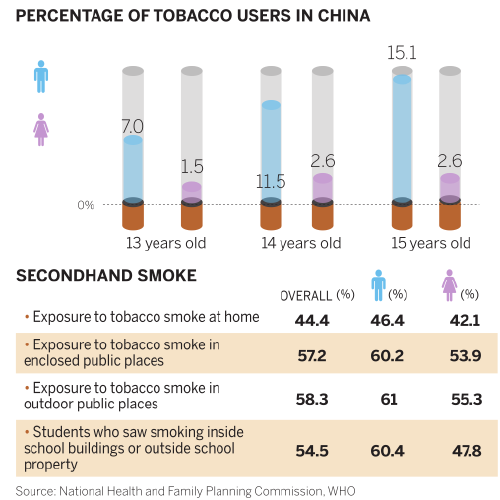Survey exposes teenage smoking risk
点击量:116585
新闻类型:National
新闻来源:ChinaDaily
更新时间:2014-5-29 16:14:21
SHAN JUAN
About 9.4 million middle school students in China aged 13 to 15 have tried smoking and one-third have become tobacco users, the first nationwide survey on smoking among young people has found.
Among 155,000 junior high school students polled, nearly 20 percent had used tobacco and 6.9 percent became tobacco users, according to the Global Youth Tobacco Survey on China.
The survey covered 188 countries and regions. The China section was funded by the Chinese government, the US Center for Disease Control and Prevention and the World Health Organization.
It was conducted by the Chinese Center for Disease Control and Prevention last year.
Bernhard Schwartlander, the WHO representative in China, said on Wednesday: "The vast majority of smokers take up the habit while they are still teenagers. The survey data highlight the urgent need to enact policies to prevent today's young people from becoming tomorrow's tobacco consumers."
Release of the data came ahead of World No Tobacco Day, which falls on May 31 each year.
The survey found that more than 80 percent of Chinese students first tried smoking by the age of 13.
More girls had smoked, particularly those in the eighth and ninth grades at the ages of 13 and 14, the survey found. Some 2.2 percent of female students in the 10th grade were smoking, compared with the average of 2.4 percent for all females aged 15 and older.
Young people in rural areas were more likely to start smoking than their urban counterparts, the survey showed.
This trend was especially apparent in major tobacco planting and producing regions such as Yunnan, Henan and Hunan provinces.
Xiao Lin, a public health specialist at the Chinese Center for Disease Control and Prevention, said China was among the bottom third in the global survey in terms of the severity of smoking among young people.
Cui Li, vice-minister of the National Health and Family Planning Commission, said given that tobacco marketing often targeted young people, "there is an urgent need for a comprehensive ban on all forms of tobacco marketing to protect young people from the hazards of a lifetime of addiction."
However, despite a government ban on tobacco advertising, 48.5 percent of the students had noticed tobacco advertisements or promotions on TV or at sales points, the survey found.
Wu Yiqun, deputy director of Think Tank, an NGO committed to greater controls on tobacco and smoking, said tobacco advertising in recent years had begun to move online, where it remained unregulated.
The survey also indicated that young people had easy access to tobacco. Sixty-five percent of youngsters who smoked said they were able to buy cigarettes near school campuses, and 80 percent said they had never been refused cigarettes because of their age. There is no legal age limit on smoking in China but it is illegal to sell cigarettes to people under 16.
About 25 percent said they bought individual cigarettes rather than whole packs.
According to WHO estimates, in low-and middle-income countries, including China, a 10 percent increase in the price of tobacco products leads to a 5 percent reduction in tobacco use.
Teh-wei Hu, a professor of health economics at the University of California, Berkeley, said the reduction was especially apparent among price-sensitive young people, who reduced their consumption two to three times more than adults did when tobacco prices were increased.
The survey found that 73 percent of students were exposed to secondhand smoke at home or in public places, and more than 50 percent of students reported exposure to secondhand smoke at school.
Eleven percent said they had seen teachers smoking indoors almost every day.
Schwartlander said, "This highlights the urgent need for effective smoke-free laws and policies that protect young people from the toxic smoke of others."
Cui agreed and urged groups such as doctors, teachers and civil servants to take the lead in promoting a tobacco-free environment and culture.
Nearly 75 percent of Chinese students said they had received anti-tobacco messages in the past 30 days and 36.5 percent had been taught at school in the past year about the harmful effects of tobacco.
Some 74 percent considered secondhand smoke to be harmful and more than 66 percent supported a smoking ban at indoor public areas.
FENG XIUXIA/CHINA DAILY
YOUNG PUFFERS
(736 Words in Total)

分享:
责任编辑:文冰纪 
评论(显示前六条)
测试账号:2014-6-2 23:02:53:
测试~~
|
|

![]()